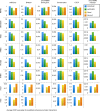Promoter-enhancer interactions identified from Hi-C data using probabilistic models and hierarchical topological domains
- PMID: 29269730
- PMCID: PMC5740158
- DOI: 10.1038/s41467-017-02386-3
Promoter-enhancer interactions identified from Hi-C data using probabilistic models and hierarchical topological domains
Abstract
Proximity-ligation methods such as Hi-C allow us to map physical DNA-DNA interactions along the genome, and reveal its organization into topologically associating domains (TADs). As the Hi-C data accumulate, computational methods were developed for identifying domain borders in multiple cell types and organisms. Here, we present PSYCHIC, a computational approach for analyzing Hi-C data and identifying promoter-enhancer interactions. We use a unified probabilistic model to segment the genome into domains, which we then merge hierarchically and fit using a local background model, allowing us to identify over-represented DNA-DNA interactions across the genome. By analyzing the published Hi-C data sets in human and mouse, we identify hundreds of thousands of putative enhancers and their target genes, and compile an extensive genome-wide catalog of gene regulation in human and mouse. As we show, our predictions are highly enriched for ChIP-seq and DNA accessibility data, evolutionary conservation, eQTLs and other DNA-DNA interaction data.
Conflict of interest statement
The authors declare no competing financial interests.
Figures







References
Publication types
MeSH terms
Substances
LinkOut - more resources
Full Text Sources
Other Literature Sources
Research Materials

